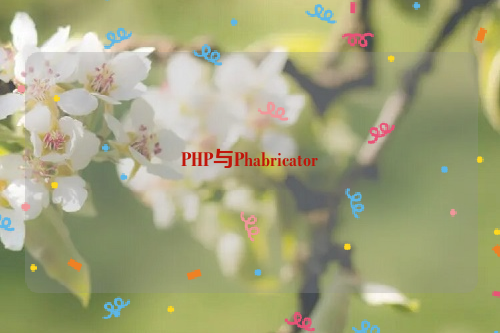<p>PHP,Java,C++与Phabricator的技术整合之旅</p><p>在当今的软件开发领域,各种编程语言和技术层出不穷,而PHP、Java和C++作为其中的佼佼者,各自拥有广泛的应用场景和庞大的开发者社区,本文将探讨如何将这三种技术与Phabricator这个强大的代码托管平台相结合,为开发者提供一个高效、便捷的开发环境。</p><p>我们需要了解什么是Phabricator,Phabricator是一个用于版本控制系统、问题追踪系统、代码审查工具以及持续集成/持续部署(CI/CD)系统的开源项目,它支持多种编程语言,包括PHP、Java和C++等,通过将这些技术与Phabricator相结合,我们可以充分利用它们各自的优势,提高开发效率。</p><p>我们将分别介绍如何在PHP、Java和C++项目中引入Phabricator。</p><p>1、PHP项目中的Phabricator集成</p><p>对于PHP项目,我们可以使用<code>PHP-phage</code>扩展来实现与Phabricator的集成,需要安装<code>php-phage</code>扩展:</p><pre class="brush:bash;toolbar:false">
pecl install php-phage</pre><p>在项目的<code>.travis.yml</code>文件中添加以下配置:</p><pre class="brush:yaml;toolbar:false">

language: php
php:
- "5.6"
install:
- composer create-project --prefer-dist php-phage/phage "${TRAVIS_BUILD_DIR}"/vendor/bin/phage.phar
- "${TRAVIS_BUILD_DIR}"/vendor/bin/phage setup --with-git=git://github.com/phacility/phage.git --with-Phabricator=http://localhost:8080 --with-gitolite=http://localhost:8080 --with-gitea=http://localhost:8080 --with-github=http://localhost:8080 --with-bitbucket=http://localhost:8080 --with-gogs=http://localhost:8080 --with-gitlab=http://localhost:8080 --with-gerrit=http://localhost:8080 --with-stash=https://github.com/phacility/phage.git --with-svn=https://github.com/phacility/phage.git --with-hg=https://github.com/phacility/phage.git --with-bzr=https://github.com/phacility/phage.git
script:
- "${TRAVIS_BUILD_DIR}"/vendor/bin/phage compile</pre><p>这样,在每次推送代码到Git仓库时,Phabricator都会自动构建并部署项目,我们还可以使用Phabricator进行代码审查、问题追踪等功能。</p><p>2、Java项目中的Phabricator集成</p><p>对于Java项目,我们可以使用<code>phabricator-api</code>库来实现与Phabricator的集成,需要在项目的<code>pom.xml</code>文件中添加以下依赖:</p><pre class="brush:xml;toolbar:false">
<dependency>
<groupId>org.example</groupId>
<artifactId>phabricator-api</artifactId>
<version>3.4</version>
</dependency></pre><p>在Java代码中使用<code>phabricator-api</code>库调用Phabricator API,实现与Phabricator的交互,获取所有待处理的问题:</p><pre class="brush:java;toolbar:false">
import com.googlecode.phabricatorapi.*; // 导入相关类
import java.io.IOException; // 导入异常处理类
import java.util.List; // 导入列表类
import java.util.concurrent.ExecutionException; // 导入并发执行异常类
import java.util.concurrent.ExecutorService; // 导入线程池类
import java.util.concurrent.Executors; // 导入线程池创建方法
import java.util.concurrent.Future; // 导入异步任务返回结果类
public class PhabiliteExample {
public static void main(String[] args) throws IOException, ExecutionException, InterruptedException {
ApiConnection api = new ApiConnection("http://localhost"); // 创建API连接对象,指定Phabricator服务器地址
ObjectOrRef<User> user = api.getCurrentUser(); // 获取当前用户信息
ObjectOrRef<Repository> repo = user.getReference().getRepository(); // 获取当前用户的第一个仓库信息
ObjectOrRef<Task> task = repo.getReference().getPendingTasks().get(0); // 获取仓库中第一个待处理任务的信息
System.out.println("Task title: " + task.getTitle()); // 输出任务标题
}
}</pre><p>这样,我们就可以利用Java与Phabricator进行交互,实现代码审查、问题追踪等功能,同样地,我们也可以将这种集成方式应用于其他编程语言的项目。</p>





还没有评论,来说两句吧...